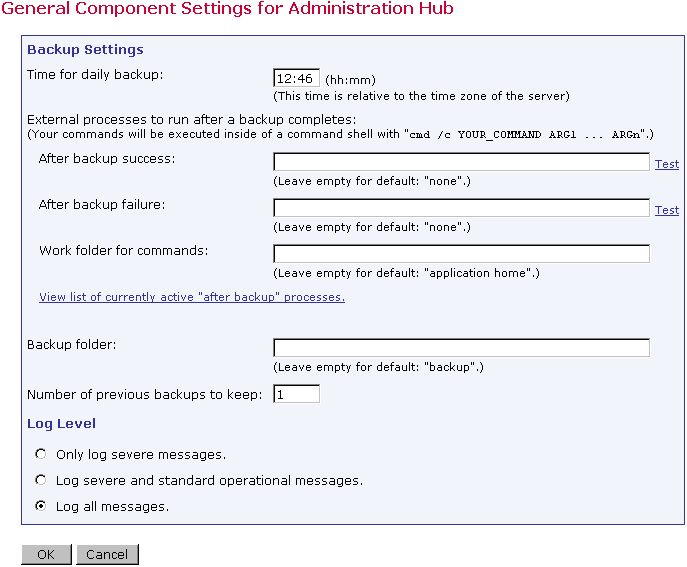Section 1
Introduction
Section 2
Configuring for First Use
Section 3
Changing Admin Password
Section 4
Creating Accounts
Section 5
Global Component Settings
Section 6
Backups
Section 7
Log Files
Section 8
User Interface Settings
Section 9
Database Connections
Section 10
Non-Standard Ports
Section 11
Firewalls
Section 12
SSL
Section 13
Tracking and Recipient Profiles
Section 14
Editing INI Files
Section 15
Distributed Components
Section 16
User Interface Branding
Section 17
Evaluation Mode
Section 18
International Character Sets
Appendix A
Standard Default Ports
Section 6
Saving and Restoring a Backup
It is a standard best practice for any administrator to make regular backups of critical software and data. LISTSERV® Maestro archives a consistent backup of the data collected in the application so that it can be restored in the event of a system failure.
LISTSERV Maestro gives the Administration Hub component the responsibility of creating a backup master to avoid any problems that might arise from having different components that store data independently and reside on different servers. If different components initiate backups at different times, inconsistent data sets between components can result. If both backups were then to be restored, the data sets would be inconsistent, invalidating the backup.
The Administration Hub will centrally trigger a backup on all connected components (including itself) in order that the backup data saved by each component is consistent with the backup data of all other components. This backup is initiated based on the values entered in the Global Component settings for the Administration Hub.
6.1 Configuring the Backup Time
The application wide backup is triggered once per day. Each day at a certain time, the Administration Hub (backup master) will start a backup of each component. To assign backup settings, click the Administration Hub link. Set the time to start the backup master by entering the desired time of the daily backup in the form “hh:mm” with values from 00:00 to 23:59.
Figure 20 General Component Settings for Administration Hub

Click OK to save settings and return to the Administer Component Settings screen.
6.2 External Post-Backup Processes
The administrator may define external processes that will be executed after a backup is completed. External processes may be used to execute additional backup tasks such as automatically moving the backup folders to a tape, copying backup folders to a network drive, notifying the administrator by e-mail if the backup was unsuccessful, and so on. Two different external processes can be defined, one to be executed after a successful backup and one after a backup failure.
Each process is specified in form of an external command that is executed by the Administration Hub when the backup completes. If it is necessary to execute more than one command, they can be written into a batch file (Windows) or shell script file (Unix/Linux). If this is the case, the name of that batch/script file is entered as the external command to be executed (with all necessary parameters). The administrator may also specify the work folder for the commands (same folder for both commands).
Clicking the Test link, located next to each command box, executes the command for a testing. A new window will pop up that shows the output of the command. In this window the external process can be stopped, if necessary. Closing the popup window before the process terminates, will not stop the process, it will continue running. To view the output of the test process again (if it is still running), or to terminate it (if it does not terminate by itself), access the process by using the View list of currently active "after backup" processes link.
Important Note: Commands should not define external processes that run indefinitely. Each external process should terminate itself when it has completed the action it is supposed to execute. Processes that run continuously over time slow the server down. Eventually this will cause a crash because each time a backup finishes, a new process will be started, tying up all available system resources.
If several external processes are running using a batch/script file, make sure that all processes started by the batch/script file terminate themselves at some point. If you start an external process that does not terminated itself (because of a defect in the external process, or by mistake), click on the View list of currently active "after backup" processes link.
This screen displays a list of all currently active external processes started by the Administration Hub, either as an actual "after backup" process that was started when a backup was completed, or because the administrator clicked on one of the Test links. Only processes that are still running are shown in this list. Each process is shown with the date and time it was started, the command that was used to start it, and a link that opens a pop-up window. The pop-up window continuously shows the output of the external process (if any) and allows for the termination of that process while it is still running.
If any of the command fields are left empty, no external process will be started at the corresponding "after backup" condition. If the work folder is left empty, then the application home folder of the Administration Hub will be used as the work folder.